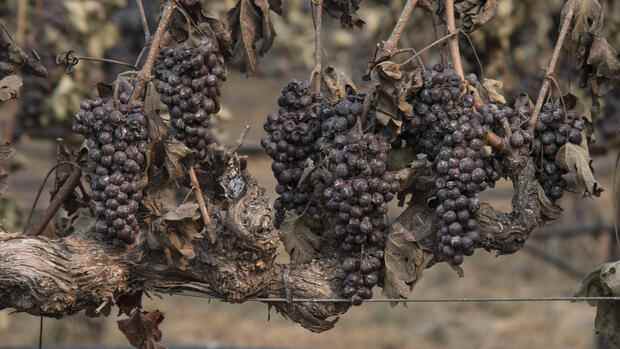san francisco Sunscreen is a must in summer—even in Napa Valley. Today, however, this no longer only applies to California’s winegrowers, but also to the grapes themselves. Ray Hannigan of the “Green and Red” winery in St. Helena began spraying a special liquid clay mixture on vines, leaves and grapes in 2021. to protect them from the sun’s rays at temperatures of around 50 degrees Celsius.
Whether this is a long-term solution remains to be seen. Hannigan’s action demonstrates the growing desperation in the wine region. Recently, the owners of the Green Island Vineyard winery applied to have their land declared an industrial zone. The country is “no longer usable” for wine-growing. Civic associations and environmentalists are up in arms. They fear a domino effect.
Where some of the best wines in the world have been produced up to now, the effects of the climate crisis are becoming more and more evident. As temperatures rise, forest fires foul the grapes with ash and dirt. The long periods of drought provide too little water for the vines and make the soil as hard as concrete slabs.
According to an estimate by the US National Academy of Science from 2020, a further rise in temperatures by two degrees Celsius could result in a loss of up to 56 percent of all wine-growing areas worldwide.
Top jobs of the day
Find the best jobs now and
be notified by email.
The Northern California valley also became internationally known for its wines in the mid-1970s. The winegrowers in the valley cultivate a total of 17,000 hectares. A good 44,000 people work in the wine industry here. The Napa Valley Vintners association estimates local economic output at around 9.4 billion dollars. The Wine Institute in California, an advocacy group for local winemakers, estimates that the state as a whole produces 81 percent of US wine production, with an output of around $40 billion.
Midwest benefits from climate change when it comes to wine
While climate change poses a serious threat to winegrowing in European regions such as Bordeaux or Tuscany and the Napa Valley in the USA, it is an opportunity for the previously less well-known winegrowing regions. These include the states of the Midwest, which up to now have been better known in the food sector for wheat or cheese. But the wine is catching up there.
The wine-growing regions are shifting towards the north.
(Photo: dpa)
Whereas Illinois had only 12 wineries in 1997, today there are more than 165, according to the Illinois Grape Growers and Vintners Alliance. That’s still just enough for 18th place among the US wine-growing states, but the rise is becoming apparent.
In addition to Illinois, Wisconsin is also rising in wine growing: the state is partly on the 44th parallel, where in Europe Tuscany and Bordeaux can also be found. Average temperatures in Wisconsin have risen a good 2.5 percent since 1950 and are now on average similar to those in the Mediterranean. In addition, it rains enough to irrigate the vines.
Another problem are the low temperatures in winter of up to minus ten degrees Celsius. Here the winegrowers are hoping for some newly bred “hybrid grapes”. They should withstand these temperature differences well.
As does the Front Neck Blanc, a white grape that has been on the market for a good 15 years. Nick Havlik, the operator of “Hav Vineyards”, emphasizes that these grapes can take a lot of sun. There is no talk of additional “sun protection” in Wisconsin. Havlik’s four-acre winery is located in Saukville. “Hav Vineyards” is not yet well known, the winemaker admits: “Nobody knows that we are here.”
More Handelsblatt articles on climate change and the USA:
But that should change. “It’s no secret,” Havlik said in an interview with Newsy, “that wine growers are leaving California and looking for new opportunities all over the Midwest.” Wisconsin is the unknown country with undiscovered opportunities for viticulture.
New customers from social media
However, there are challenges, says Havlik. The harvest time is mid-May to October, which makes it difficult to reach optimal maturity. The wine drinkers themselves are also a problem, as they often use the varieties they are familiar with. Hybrid grapes also have their own flavors, which winemakers have to make palatable to customers. Havlik therefore relies on social media and younger wine drinkers who are more open to new varieties.
The consequences of climate change are becoming increasingly clear in the state.
(Photo: AP)
At least according to a study by the Silicon Valley Bank on the wine industry, this is the right strategy: in 2021, wine consumption no longer increased, but fell slightly. Spirits, on the other hand, increased. Chardonnay and Cabernet Sauvignon, high-margin and very popular with Californian winemakers, each lost almost seven percent in sales. Rob McMillan, author of the study, makes it clear: “The wine industry needs to win over millennial shoppers.”
Climate change is also a major challenge for German viticulture. Riesling wines will be harder to produce, German Eiswein could disappear entirely. With the rising temperatures, popular red wine grapes from the Mediterranean regions could perhaps grow in the classic white wine country of Germany.
It is also possible that Merlot will thrive in the Lüneburg Heath in the future. Or a hybrid Front Neck Blanc from Wisconsin.
More: Researchers warn: Europe is threatened by drought phases of up to 15 years
